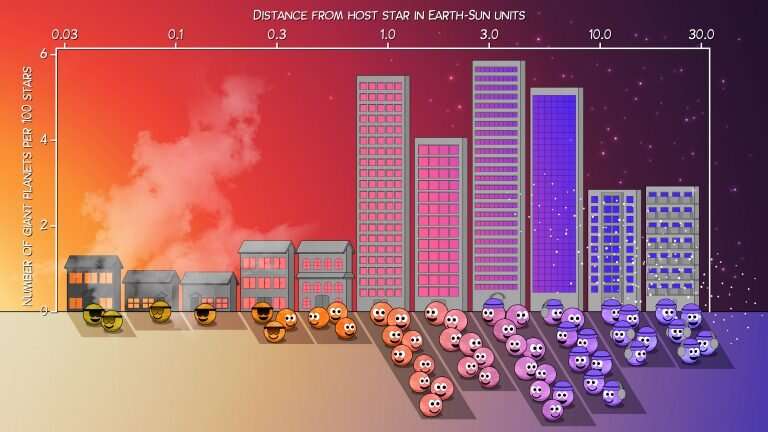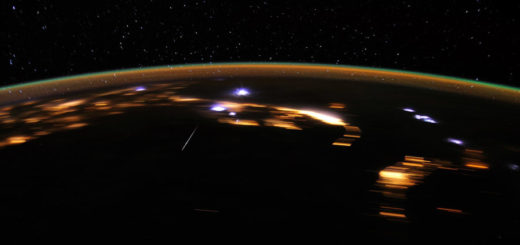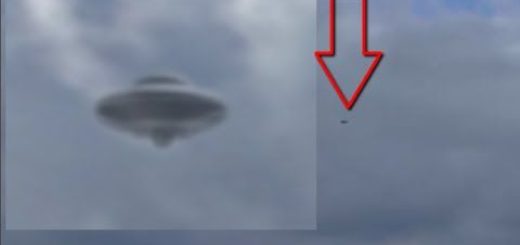30-year stellar survey cracks mysteries of galaxy’s giant planets

Current and former astronomers from the University of Hawaiʻi Institute for Astronomy (IfA) have wrapped up a massive collaborative study that set out to determine if most solar systems in the universe are similar to our own. With the help of W. M. Keck Observatory on Maunakea in Hawaiʻi, the 30-year planetary census sought to find where giant planets tend to reside relative to their host stars.
In our solar system, the giant planets—Jupiter and Saturn—are found in the chilly outer regions, while smaller planets tend to orbit closer to the Sun. Earth lives in an intermediate tropical zone well-suited to life, at a distance of 1 AU (astronomical unit) from the Sun. Jupiter is about 5 AU from the Sun, and Saturn is at 9 AU. An AU, the distance from the Earth to our Sun, is about 93 million miles.
“Dynamically speaking, Jupiter and Saturn are the VIPs—Very Important Planets—of the solar system,” said IfA Parrent Postdoctoral Fellow Lauren Weiss. “They are thought to have shaped the assembly of the terrestrial planets, potentially stunting the growth of Mars and slingshotting water-bearing comets toward Earth.”
We are normal
New data reveals that, on average, there are 14 cold giant planets per 100 stars in the galaxy, so although the solar system is not the most common type of planetary system in the galaxy, it is well represented. The number of giant planets detected around nearby stars suggest that billions of giant planets reside in the Milky Way Galaxy.
Researchers also found that giant planets tend to reside about 1 to 10 AU from their host stars, a mostly icy region located beyond these stars’ temperate zones.
The research team included Weiss, former IfA graduate student BJ Fulton, and former IfA professor Andrew Howard, who is now a Caltech professor of astronomy. Fulton, now a staff scientist at Caltech’s astronomy center, received the Astronomical Society of the Pacific’s 2018 Robert J. Trumpler Award, recognizing his Ph.D. thesis work on the distribution of extrasolar planet masses as unusually important to astronomy.
The new research is reported in two journal articles accepted for publication in the Astrophysical Journal Supplement. Lee Rosenthal, a graduate student at Caltech who works with Howard, is lead author of one study, and Fulton is lead author of the second paper.
his graph of data collected by the California Legacy Survey indicates that most giant planets in the galaxy tend to reside about 1 to 10 astronomical units (AU) from their host stars. An AU is defined as the distance from Earth to our sun, or about 93 million miles. This is similar to what we see in our own solar system: Earth orbits at 1 AU; Jupiter is situated at about 5 AU and Saturn at 9 AU. Credit: California Legacy Survey/T. Pyle (Caltech/IPAC)
Maunakea plays key role in data collection
Researchers observed 719 sun-like stars for more than three decades, finding 177 planets, including 14 that were newly discovered. The planets have masses between one-hundredth and 20 times the mass of Jupiter.
The project, called the California Legacy Survey, originated in the Golden State in the 1990s; half of the data was obtained using Keck Observatory’s High-Resolution Echelle Spectrometer (HIRES). It is the longest-duration exoplanet survey to date.
Rosenthal explains that the survey was designed to be unbiased by carefully selecting random stars, “as if you could put your hand in a grab bag of stars and pull a random planet out.” Working on this project as part of his Ph.D. thesis, Rosenthal says it was “humbling to work on a 30-year project where some of the data are older than I am.”
In our solar system, we also have planets that are a bit smaller than Jupiter and Saturn, Uranus and Neptune, which are located out beyond Saturn. The California Legacy Survey is not sensitive to planets in that size range and at that distance.
“While we can’t detect smaller planets similar to Neptune and Uranus that are very distant from their stars, we can infer that the large gas giants like Jupiter and Saturn are extremely rare in the outermost regions of most exoplanetary systems,” explained Fulton.
“This survey is a great jumping-off point for future instruments that are sensitive to planets the size of Earth,” said Howard, who is leading one such cutting-edge instrument, the Keck Planet Finder, which is expected to be shipped to Keck Observatory in 2022.
The collaboration included researchers from IfA, Caltech, and the University of California, and primarily used Keck Observatory and the Shane and Automated Planet Finder telescopes at Lick Observatory, near San Jose, California.
The team plans to continue to sift through data for new patterns and clues to help understand the characteristics and formation of other star systems, as well as our own solar system. They are also looking forward to next-generation surveys.
The first paper in the series, led by Rosenthal, is titled “The California Legacy Survey I. A Catalog of 177 Planets from Precision Radial Velocity Monitoring of 719 Nearby Stars Over Three Decades.” The second paper in the series, led by Fulton, is titled “California Legacy Survey II. Occurrence of Giant Planets Beyond the Ice Line.”



 Creators of mankind
Creators of mankind Description of “Tall white aliens”
Description of “Tall white aliens” Where they came from?
Where they came from? About hostile civilizations
About hostile civilizations The war for the Earth
The war for the Earth “Tall white aliens” about eternal life
“Tall white aliens” about eternal life Video: “Nordic aliens”
Video: “Nordic aliens” Aliens
Aliens Alien encounters
Alien encounters The aliens base
The aliens base UFO
UFO Technology UFO
Technology UFO Underground civilization
Underground civilization Ancient alien artifacts
Ancient alien artifacts Military and UFO
Military and UFO Mysteries and hypotheses
Mysteries and hypotheses Scientific facts
Scientific facts


















